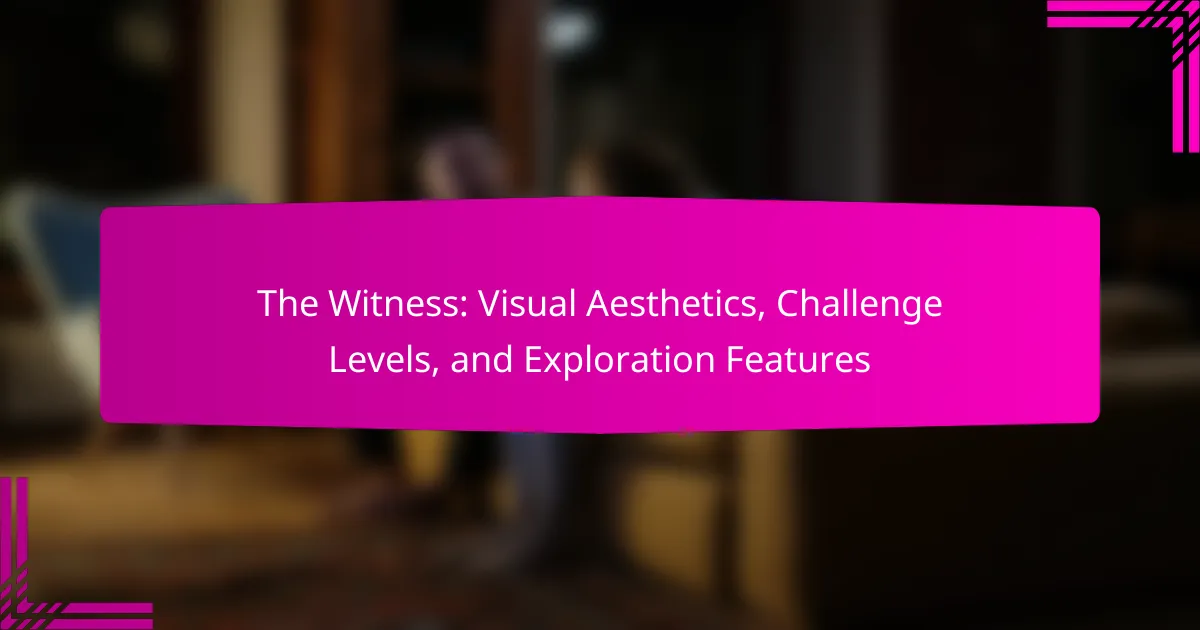The Witness offers a unique gaming experience through its stunning visual aesthetics, diverse challenge levels, and immersive exploration features. Players encounter vibrant landscapes and intricate puzzles that vary in complexity. The game encourages curiosity and problem-solving, rewarding exploration with hidden secrets and environmental storytelling. Each aspect contributes to a deep and engaging journey that appeals to a wide range of players.
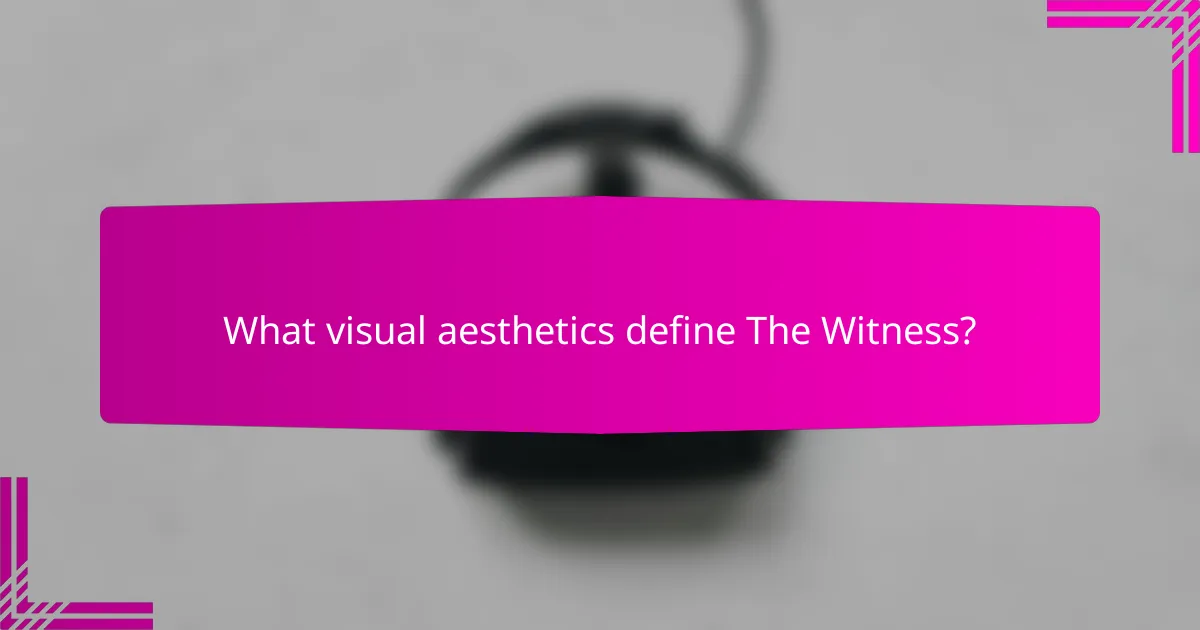
What visual aesthetics define The Witness?
The visual aesthetics of The Witness are defined by vibrant colours, minimalist design, and intricate patterns. The game features a diverse landscape, including lush gardens and stark deserts, each crafted with attention to detail. Unique attributes include the use of light and shadow to create depth and atmosphere. The art style emphasises clarity, enhancing the puzzle-solving experience while immersing players in an engaging environment.
How does colour theory influence gameplay experience?
Colour theory significantly enhances gameplay experience in “The Witness” by influencing player emotions, guiding exploration, and providing visual cues. The game’s vibrant palette creates a serene atmosphere, while contrasting colours highlight puzzle elements, enhancing challenge levels. This intentional use of colour fosters deeper engagement and exploration, encouraging players to interact with the environment more thoughtfully.
Which environmental designs enhance immersion?
Environmental designs that enhance immersion in “The Witness” include vibrant colours, intricate landscapes, and interactive puzzles. These elements create a captivating atmosphere that draws players into the experience. The use of light and shadow adds depth, while the diverse environments encourage exploration. Unique attributes such as the seamless integration of sound design further enrich the immersive experience, making each location feel distinct and alive.

What are the challenge levels in The Witness?
The Witness features three challenge levels: easy, medium, and hard. Each level presents puzzles that vary in complexity and require different problem-solving skills. Easy challenges introduce basic concepts, while medium challenges build on these with added layers of difficulty. Hard challenges demand advanced logic and spatial reasoning, often integrating multiple mechanics. This tiered approach enhances player engagement and exploration, encouraging mastery of the game’s visual and cognitive elements.
How do puzzles vary in difficulty throughout the game?
Puzzles in “The Witness” vary in difficulty by introducing increasingly complex mechanics and spatial challenges. Early puzzles focus on basic line-drawing techniques, while later ones incorporate multiple layers, requiring players to think critically and experiment. The game’s design encourages exploration, with environmental cues that hint at solutions, creating a dynamic learning curve. Players encounter unique attributes in puzzle design, such as the integration of visual aesthetics that enhance the challenge experience.
What strategies can players use to tackle challenging puzzles?
Players can tackle challenging puzzles in “The Witness” by employing observation, experimentation, and pattern recognition strategies. First, carefully examine the environment for clues. Second, practice solving simpler puzzles to build confidence. Third, consider the relationships between different puzzle types. Fourth, take breaks to gain fresh perspectives. Finally, collaborate with others for new insights.
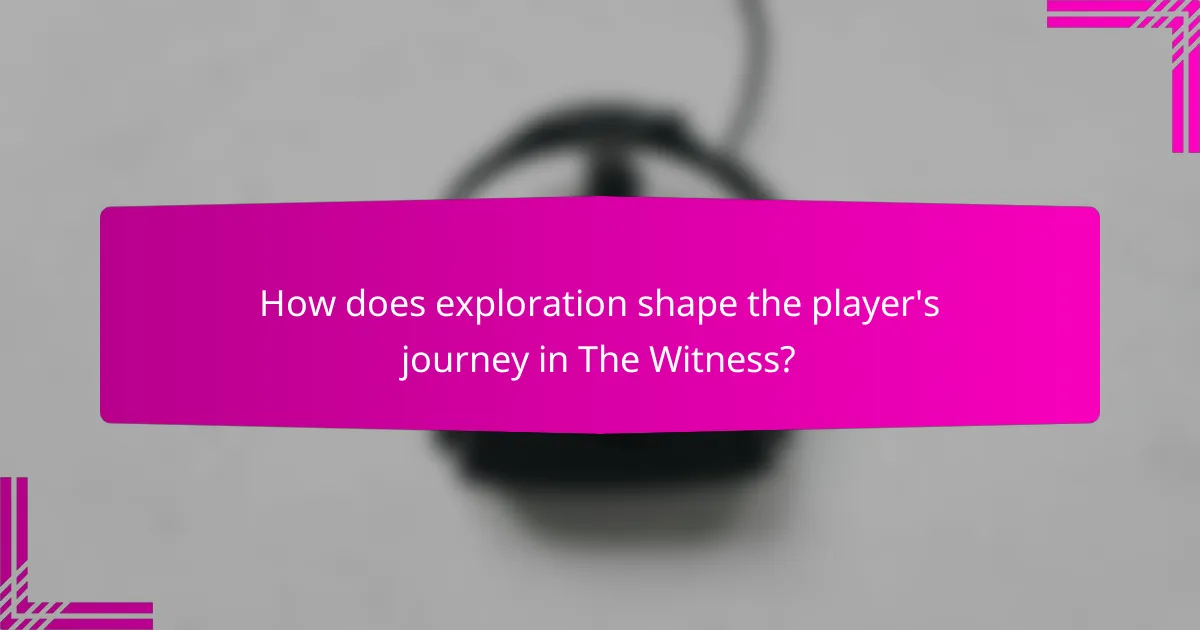
How does exploration shape the player’s journey in The Witness?
Exploration significantly shapes the player’s journey in The Witness by immersing them in a visually stunning environment that encourages curiosity and problem-solving. The game’s open-world design allows players to discover puzzles organically, fostering a sense of achievement. Unique attributes like environmental storytelling enhance the experience, as players piece together the narrative through exploration. As a result, each player’s journey becomes a personal discovery, influenced by their choices and interactions with the world.
What are the key areas to explore for hidden secrets?
To explore hidden secrets in “The Witness,” focus on visual aesthetics, challenge levels, and exploration features. These areas enhance the player’s experience and uncover intricate puzzles and environments.
Visual aesthetics play a crucial role, as the vibrant landscapes and detailed environments often hide clues and secrets. Challenge levels vary, offering players different degrees of difficulty, encouraging exploration and experimentation. Exploration features, such as environmental storytelling and interactive elements, further enrich the gameplay and reveal hidden aspects of the game world.
How does exploration impact puzzle-solving?
Exploration significantly enhances puzzle-solving in “The Witness” by encouraging players to engage with the environment. The game’s intricate visual aesthetics and challenge levels require players to observe details, leading to deeper understanding and innovative solutions. As players explore, they encounter unique attributes like hidden clues and varying puzzle types, which stimulate critical thinking. This interaction fosters a sense of discovery, making the puzzle-solving experience more rewarding and immersive.
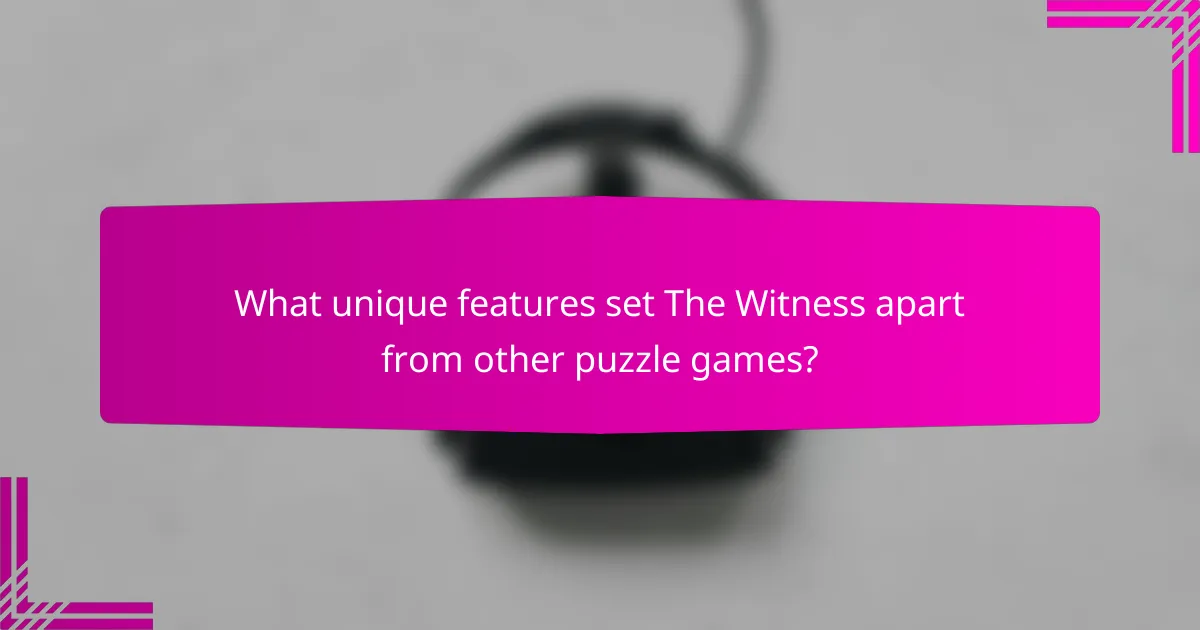
What unique features set The Witness apart from other puzzle games?
The Witness stands out due to its stunning visual aesthetics, intricate challenge levels, and unique exploration features. The game’s vibrant art style immerses players in a beautifully crafted world. Each puzzle integrates seamlessly into the environment, enhancing the overall experience. The challenge levels vary significantly, catering to both casual and hardcore gamers. This variety encourages players to engage deeply with the game. Exploration is rewarded, as players uncover hidden areas and secrets that enrich the narrative. Overall, these unique features create a distinctive gaming experience that sets The Witness apart from other puzzle games.
How does the narrative intertwine with gameplay mechanics?
The narrative in “The Witness” enhances gameplay mechanics by creating an immersive experience. The interconnected puzzles reflect the philosophical themes of observation and understanding. Exploration encourages players to engage with the environment, revealing narrative elements through visual storytelling. This design fosters a deeper connection between gameplay and the overarching narrative, making each discovery meaningful.
What innovative puzzle designs are exclusive to The Witness?
The Witness features innovative puzzle designs that emphasise environmental interaction and visual storytelling. Unique puzzles integrate elements of light, shadow, and colour, enhancing the immersive experience. Rare designs challenge players to think critically about their surroundings, with solutions often hidden in the landscape. The game’s aesthetic coherence supports its puzzles, making each challenge a visual and intellectual delight.
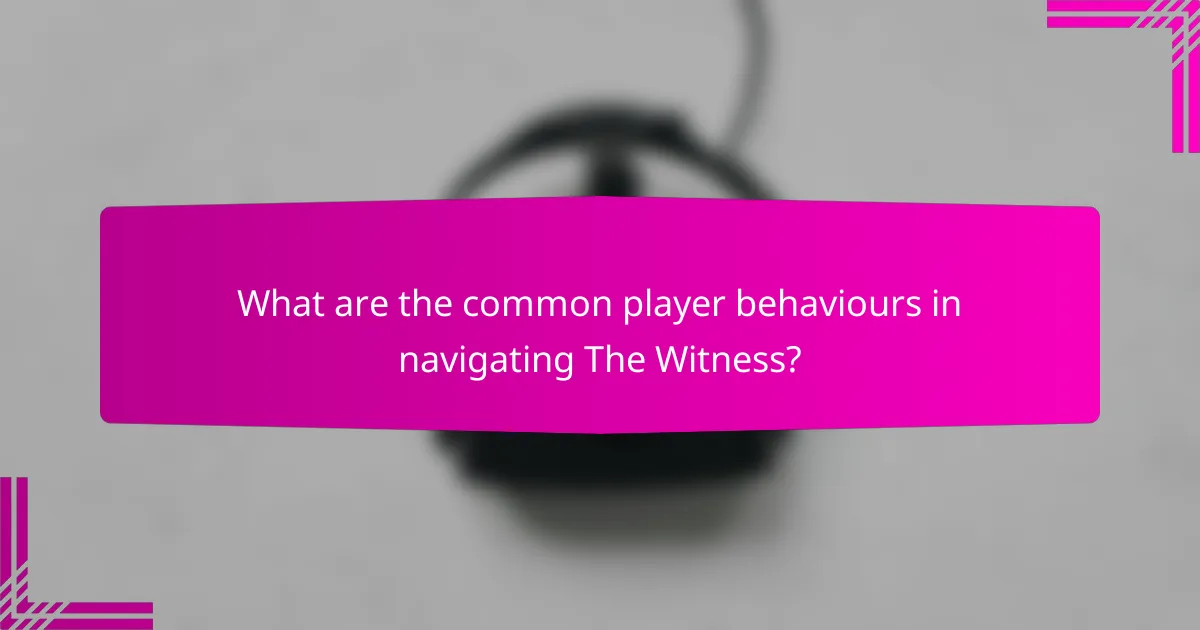
What are the common player behaviours in navigating The Witness?
Players in The Witness often exhibit exploration-driven behaviours, focusing on solving puzzles and uncovering environmental secrets. Common behaviours include thorough scanning of the environment, experimenting with puzzle mechanics, and revisiting areas for missed clues. Players frequently engage in collaborative problem-solving, sharing insights with others to tackle complex challenges. This exploration fosters a sense of discovery, enhancing the overall gameplay experience. Additionally, players may develop unique strategies for navigating the game’s intricate landscapes and puzzle designs, showcasing individual problem-solving approaches.
How do players approach exploration versus puzzle-solving?
Players in “The Witness” often balance exploration and puzzle-solving by immersing themselves in the environment while strategically engaging with challenges. Exploration encourages players to uncover hidden areas and gather visual clues, enhancing their understanding of the game’s mechanics. Puzzle-solving requires critical thinking and pattern recognition, often influenced by the surrounding landscape.
The game’s visual aesthetics play a crucial role in guiding players, with vibrant colours and distinct environments signalling areas of interest. As a result, players may prioritise exploration to discover new puzzles or insights that facilitate their progress. The challenge levels vary, with some puzzles requiring deeper exploration to unlock solutions.
In essence, players approach exploration as a means to enrich their puzzle-solving experience, creating a dynamic interplay that defines gameplay in “The Witness.”
What mistakes do players often make while playing?
Players often make mistakes by overlooking environmental clues, rushing puzzle solutions, and failing to explore thoroughly. Many miss critical details that enhance their understanding of the game’s visual aesthetics. Additionally, players may underestimate challenge levels, leading to frustration. A common error is not experimenting with different approaches, which can limit exploration features and hinder progress.
What expert tips can improve the gaming experience in The Witness?
To enhance the gaming experience in The Witness, focus on exploration, patience, and observation. Engage deeply with the environment; many puzzles are designed to encourage players to notice subtle details. Take breaks to avoid frustration, as stepping away can provide fresh perspectives on challenging puzzles. Utilise the in-game hints wisely, as they can guide without spoiling the experience. Lastly, embrace the game’s aesthetic, allowing the visuals to inspire creativity and problem-solving.
